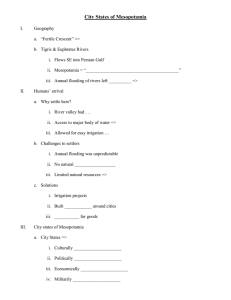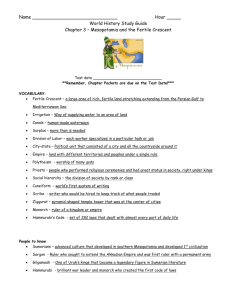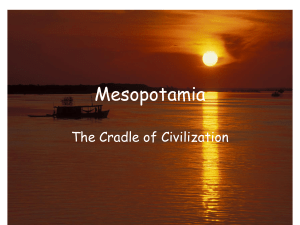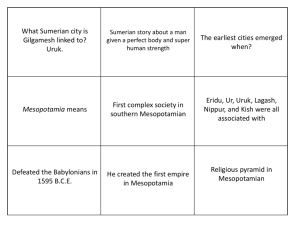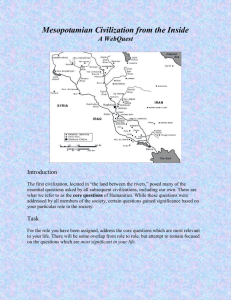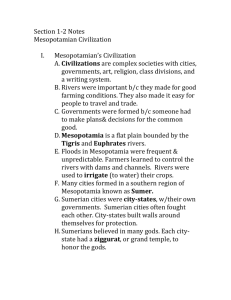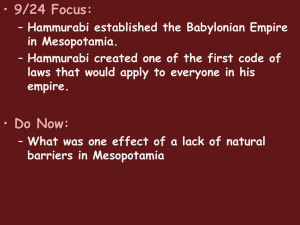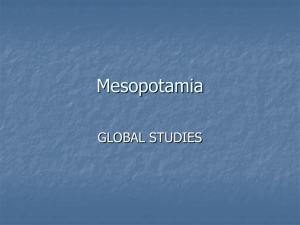to download.
advertisement
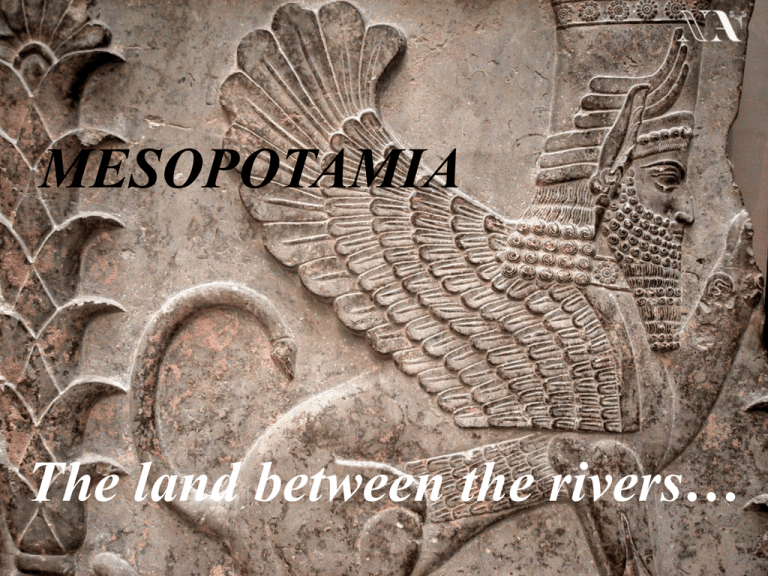
MESOPOTAMIA The land between the rivers… The name Mesopotamia (land between the rivers) refers largely to the area of modern Iraq. At various times, it included: •Sumeria •Akkad •Assyria •Babylonia •At times, because of the geography, many other cultures invaded and had an influence • before 8000 BCE, there was sparse inhabitation •Gradually, plants and animals became domesticated •The food supply increased, populations increased, and the nomadic way of life was abandoned – villages, then towns and cities would evolve •Irrigation would occur, as there was little rainfall •With irrigation and agriculture came the need for government and laws, to organize, direct and protect workers, to record land ownership etc. •Trade evolved, as there were few resources – no stone, wood, metals – they would need to trade what they HAD for what they LACKED Southern Mesopotamia grew rapidly. During the early Sumerian period (c. 3100-2000 BCE) the following emerged: • • • • • • • • Flood control Writing system Religious literature Monumental architecture Economic organization Codification of laws Weights and measures Concept of the city-state Mesopotamia was very open to invasion – there were many conquerors The culture was enriched, but not absorbed – rather, the conqueror’s culture was absorbed into the existing culture THIS WAS DUE TO GEOGRAPHY…….NO NATURAL FEATURES TO PROTECT MESOPOTAMIA Pottery • Traditions of making painted pottery flourished in agricultural villages and nomad camps throughout the Near East by the Late Neolithic period of the seventh millennium B.C.E. • These early ceramics were made by hand in a variety of techniques, including coil, mold, and slab construction, and served as cooking, serving, and storage vessels. • Most early pottery is STYLIZED, simple, and GEOMETRIC • Decoration becomes more sophisticated and intricate as time goes on Storage jar decorated with mountain goats, early 4th millennium B.C.E. Central Iran Ceramic, paint; H. 20 7/8 in. (53 cm) Funerary beaker in Susa A style graveyard outside Susa. Ca. 4000 B.C. The horns of a stylized ibex sweep up in a geometric design, and the rim decoration consists of long necked water birds in a formal arrangement. Archaeological Museum, Teheran, Iran. Funerary beaker in Susa A style from extramural graveyard at Susa. 10.5" tall. Elegant geometric design with stylized foliage. Early 4th millennium B.C.E. Le Louvre, Paris. Susa pottery bowl with dark brown geometric designs and birds on buff ground. Late 4th millennium. B.C.E. British Museum, UK. RITUAL OBJECTS Tell Asmar figurines c. 2700 BCE VOTIVE FIGURINES Gods, priests, worshippers – Hierarchy of size, up to about 30 “ Conventions • Artistic conventions evolve according to the accepted style or tradition of a certain culture at a certain time and place – therefore, characteristics we seem to find repeated often – almost a formula • What might be conventions in the Tell Asmar statues? Conventions • • • • • • Hierarchy of size Cylindrical, closed forms Pose of supplication – prayer – hands clasped Simplification Stylized Wide, staring eyes – window to the soul? Allseeing? • Votive figurines were left as stand-ins – when the person was dead, or away, or busy? Gudea, Prince of Lagash, ca. 2120 BCE, ca. 75 cm high Female votive worshipper – Khafaje 2600-2400 BCE enamel inlay from a wall excavated at Susa. Important Sumerian developments include: • The concept of the city-state • Writing • The concept of a powerful god communicating their desires to humanity through the medium of a powerful priest class or autocratic ruler • Government by a priest class through religious power is known as a THEOCRACY • This system centralizes power in the hands of a small group of people and gives political decisions a religious authority ZIGGURAT – UR the temple was central ….the social cement” that bound the community together - • The ZIGGURAT was a temple raised up above the common level from which announcements might have come down from the gods • It may symbolize an artificial mountain (mound) – closer to the gods? • Mountains are sacred in many cultures – Mount Olympus – Ancient Greece • Only priests went to the top (Mayans did this as well) • Stairs and ramps represent the path up the symbolic mountain – a spiritual journey to receive guidance • Built of mudbrick – little stone or wood in Southern Iraq Oval temple at Khafaje NIPPUR NIPPUR UR Headdress with leaf-shaped ornaments, 2600–2500 B.C.E. Sumerian style Excavated at "King's Grave," Ur, Mesopotamia Gold, lapis lazuli, carnelian; L. 15 3/16 in. (38.5 cm) Four strands of beads, 2500–2400 B.C.E Excavated at the "Great Death Pit," Ur, Mesopotamia Gold, lapis lazuli; L. 21.26 in. (54 cm) Lunate earrings, 2500–2400 B.C.E Excavated at the "Great Death Pit," Ur, Mesopotamia Gold RAM IN A THICKET – UR Ur – 2800 BCE – 18” May represent the god TAMMUZ – male principle in nature Things really haven't changed much in the 4500 years since the ram statuette was fashioned in ancient Ur as can be seen from this 1999 photograph of African gerenuk on their hind legs eating the leaves of an acacia tree. Lyre Soundbox of Queen Puabi (18”) Images (mythical beings) organized into registers, anthropomorphism evident – Mesopotamian interest in combined creatures – human/animal combinations OBJECT OF STATE - The Standard of Ur - 2600-2500 BCE ROYAL STANDARD – UR- about 18”, shell, lapis lazuli, sound box • The figures on the standard commemorate all aspects of life in Sumer • Art is a reflection of the culture from which it springs • In this case, the standard gives us a narrative of Sumerian life and culture • It is divided into registers • Very STYLIZED combination of profile and frontal poses – similar to the Egyptian way of portraying the human figure Standard of Ur – Scenes of Peace The king holds a banquet, while commoners bring gifts of livestock, produce and manufactured goods Standard of Ur – Scenes of War Soldiers in battle lead prisoners to the king – the king rides his chariot over the dead – propaganda – use of fear to impress their enemies Ashurbanipal's brutal campaign against Susa is triumphantly recorded in this relief showing the sack of Susa in 647 BCE. Here, flames rise from the city as Assyrian soldiers topple it with pickaxes and crowbars and carry off the spoils. ASSYRIAN – TRADE ON THE TIGRIS Anthropomorphism Assyrian eagle-headed spirit Power and Authority • To regulate trade, and matters of state, a powerful government evolved • The king’s court was luxurious and powerful • The king built temples, administered justice, maintained canals for irrigation • At first, kings were elected, then they became hereditary • Sumerians claimed their kings were appointed by heaven • Monarch’s main job was to wage war • Conflict over land and water rights was common • First professional army Relief – Dying Lioness, Palace of Ashurbanipal, Nineveh, Iraq, bas relief panel, limestone, figure: 13.75" h, c. 669-633 B.C. (British Museum, London): • Killing lions was strictly a royal activity or ritual • Is the lion shown sympathetically? • Lion often a royal symbol ASHURBANIPAL HUNTING – NINEVAH – 7TH C. BCE The History of Writing • Language existed long before writing • the signature event that separated the emergence of palaeohumans from their anthropoid progenitors was not tool-making but a rudimentary oral communication that replaced the hoots and gestures still used by lower primates. • The transfer of more complex information, ideas and concepts from one individual to another, or to a group, was the single most advantageous evolutionary adaptation for species preservation. • As long ago as 25,000-30,000 years BCE, humans were painting pictures on cave walls. Whether these pictures were telling a "story" or represented some type of "spirit house" or ritual exercise is not known. • The advent of a writing system, however, seems to coincide with the transition from hunter-gatherer societies to more permanent agrarian encampments • perhaps it became necessary to count one’s property, whether it be parcels of land, animals or measures of grain, or to transfer that property to another individual or another settlement. •We see the first evidence for this with incised "counting tokens" about 9,000 years ago in the Neolithic fertile crescent. • Around 4100-3800 BCE, the tokens began to be symbols that could be impressed or inscribed in clay to represent a record of land, grain or cattle and a written language was beginning to develop. One of the earliest examples was found in the excavations of Uruk in Mesopotamia at a level representing the time of the crystallization of the Sumerian culture. • The pictures began as representing what they were, pictographs, and eventually, certain pictures represented an idea or concept, ideographs, and finally to represent sounds. • head foot sun"day“ hand woman It's tempting to claim that the development of a writing system was necessitated by the need to keep track of beer, but perhaps we can be satisfied that it was just part of it. • Eventually, the pictographs were stylized, rotated and in impressed in clay with a wedge shaped stylus to become the script known as Cuneiform. The pictograph for woman, as seen above became: • Written language was the product of an agrarian society. These societies were centered around the cultivation of grain. A natural result of the cultivation and storage of grain is the production of beer. It is not surprising, therefore, that some of the very oldest written inscriptions concern the celebration of beer and the daily ration allotted to each citizen. Early cylinder seal depicting beer production CYLINDER SEALS Cuneiform (wedge-shaped) Babylonian school tablet - Hammurabi Dynasty (circa 19001600 B.C.E.). KUDURRUS – BOUNDARY MARKERS Hammurabi’s Law Code “AN EYE FOR AN EYE, A TOOTH FOR A TOOTH…” • The Code of Hammurabi is a well-preserved ancient law code, created ca. 1760 BC in ancient Babylon. It was enacted by the sixth Babylonian king, Hammurabi • Only one example of the Code survives today, inscribed on a seven foot, four inch tall basalt stone slab or stele. Originally, several stelae would have been displayed in temples around the empire. • Hammurabi (ruled ca. 1796 BC – 1750 BC) believed that he was chosen by the gods to deliver the law to his people. In the preface to the law code, he states, "Anu and Bel called by name me, Hammurabi, the exalted prince, who feared God, to bring about the rule of righteousness in the land.“ • At the top of the stele is a bas-relief image of a Babylonian god (either Marduk or Shamash), with the king of Babylon presenting himself to the god, with his right hand raised to his mouth as a mark of respect. Winged Bull – Khorsabad LAMASSU large monumental bulls, often with wings and always with human heads, were placed as gateway guardians at the entrances of royal palaces like Khorsabad and Nineveh. The general idea behind the LAMASSU was that they warded off evil. Usually, they have five legs. In one modern interpretation, they combine the strength of a bull, the freedom of an eagle, and the intelligence of a human being. WINGED BULL OF BABYLON - LAMASSU (ASSURBANIPAL) example of ANTHROPOMORPHISM ISHTAR GATE FROM BABYLON PERSEPOLIS Mural painting Mari Marsh Arabs Games and Sport • Hunting was popular among Assyrian kings. • Boxing and wrestling feature frequently in art, and some form of polo was probably popular, with men sitting on the shoulders of other men rather than on horses. • They also played majore, a game similar to rugby, but played with a ball made of wood. • They also played a board game similar to senet and backgammon, now known as the "Royal Game of Ma-asesblu." ASSYRIAN VICTORY STELE Family Life • Mesopotamia across its history became more and more a patriarchal society, in which the men were far more powerful than the women. • early Mesopotamian society was ruled by a "council of elders" in which men and women were equally represented, but that over time, as the status of women fell, that of men increased. • As for schooling, only royal offspring and sons of the rich and professionals such as scribes, physicians, temple administrators, and so on, went to school. • Most boys were taught their father's trade or were apprenticed out to learn a trade. • Girls had to stay home with their mothers to learn housekeeping and cooking, and to look after the younger children. • Some children would help with crushing grain, or cleaning birds. Unusual for that time in history, women in Mesopotamia had rights. They could own property and, if they had good reason, get a divorce. Religion • Mesopotamian religion was the first to be recorded • Mesopotamians believed that the world was a flat disc, surrounded by a huge, holed space, and above that, heaven. They also believed that water was everywhere, the top, bottom and sides, and that the universe was born from this enormous sea • Mesopotamian religion was polytheistic • The people of Mesopotamia believed that their world was controlled by gods and goddesses, demons and monsters • There were hundreds of gods who were responsible for everything in the world, from rivers and trees to making bread and pottery • Each city was protected by its own special god or goddess and their family. Large temples were built in the centre of the city for these gods to live in. Priests looked after the gods with special rituals. There were also smaller temples throughout the city where ordinary people could make offerings. • Demons were created by the gods with human bodies and animal or bird heads. They could be either evil or good. Monsters were a mixture of animals and birds. • Although the beliefs described were held in common among Mesopotamians, there were also regional variations. • The Sumerian word for universe is an-ki, which refers to the god An and the goddess Ki. • Their son was Enlil, the air god. They believed that Enlil was the most powerful god. • He was the chief god of the Pantheon, as the Greeks had Zeus and the Romans had Jupiter. • The Sumerians also posed philosophical questions, such as: Who are we?, Where are we?, How did we get here?. They attributed answers to these questions to explanations provided by their gods. • Anu was the Sumerian god of the sky • Enlil was initially the most powerful god in Mesopotamian religion • Enki (Ea) god of Eridu. He was the god of rain • Marduk was the principal god of Babylon. When Babylon rose to power, the mythologies raised Marduk from his original position as an agricultural god to the principal god in the pantheon. • Gula or Utu (in Sumerian), Shamash (in Akkadian) was the sun god and god of justice • Nabu was the Mesopotamian god of writing • Iškur (or Adad) was the god of storms. • Erra was probably the god of drought. Anu is the sky god. He is the supreme ruler of all the gods. His symbol is the horned cap. Mesopotamian myths tell the story of how the earth was separated from heaven at the beginning of time. In these myths, heaven becomes Anu's home. Anu controls shooting stars, called 'kishru'. Anu is also in charge of the Bull of Heaven who can be sent to earth to avenge the gods. Although Anu is an important Mesopotamian god, there are no known pictures of him. Enlil Enki – God of Rain Shamash – Sun God (and justice) Nabu – God of Writing Burial • • • • • • • • • Hundreds of graves have been excavated in parts of Mesopotamia, revealing information about Mesopotamian burial habits. In the city of Ur, most people were buried in family graves under their houses (as in Catalhuyuk), along with some possessions. A few have been found wrapped in mats and carpets. Deceased children were put in big "jars" which were placed in the family chapel. Other remains have been found buried in common city graveyards. 17 graves have been found with very precious objects in them ; it is assumed that these were royal graves. The burial rites of Sumerians are tied to their belief in the spirit world and they followed a strict pattern. The body was wrapped in reed matting, or occasionally placed in a coffin. The corpse was laid on its side with a bowl of water between the hands near the mouth. Some treasured belongings might go in the grave. Vessels filled with food and water were place near the body so the spirit wouldn't be hungry and return for food. The tombs were furnished according to what the family could afford...so the royal tombs were filled with treasures. Part of Mesopotamia’s legacy include: Algebra Astronomy 60 sec/min 60 min/hour The wheel – from potter’s wheel, to spoked wheel – eventually to the chariot – which would give a military advantage Concept of city-state Writing – cuneiform Concept of powerful gods communicating through a priest class – centralized power in the hands of a small group – gives political decisions a religious authority Codification of law Mesopotamia would later become part of succeeding empires: Persian Arab Ottoman And, in 1921…the modern state of Iraq
